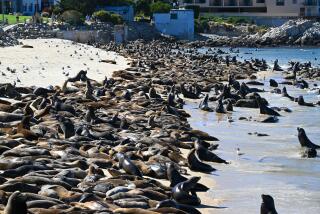Biologists Will Determine Fate of Otter Colony on San Nicolas Island : Preservation: Eleven animals live there. Officials had transferred 139 from the Monterey coast more than three years ago.
- Share via
With only 11 adult California sea otters living at San Nicolas Island after a six-year effort to establish a spinoff colony there, state and federal scientists are set to decide next month whether the experiment has failed.
It has been more than three years since the last of 139 animals was captured from the main herd of otters off the Monterey coast and transferred to San Nicolas, where it was hoped a second colony would ensure survival of the threatened species in the event of a catastrophic oil spill.
To be considered a success, the program was to have established a stable colony of at least 25 otters within three years of the last transfer, according to terms of the permit for the controversial effort.
“We’re not seeing the colony grow, and that’s a concern,” said Carl Benz, biologist and coordinator of the sea otter recovery program for the U. S. Fish and Wildlife Service. “This population is so small that it could just hang in there by itself, or go extinct on its own from dispersion or mortality.”
But Benz said a similar experiment in Washington state that has recently begun to show success proves that the population at San Nicolas could rebound as well.
The Fish and Wildlife Service is also still having trouble keeping a promise to capture any animals that swim outside the so-called management zone, which was designed to keep the voracious otters out of commercial fisheries.
Benz said a team of biologists and divers is expected to go out today for the first time since February to try to capture two of the animals at San Miguel Island, a prime fishing territory for abalone and other shellfish, staples of the playful mammals.
But capturing the animals is not only difficult for divers--divers wearing devices that don’t produce bubbles must sneak up on the lithe and wary animals and trap them--but it is very stressful for the animals, Benz said.
“They are wild animals and the shock of sudden confinement and being taken out of their element . . . all adds up to stress,” he said.
Last year, two animals that were captured in the management zone and taken back to Monterey were found dead within two weeks of their release.
“We’re trying to operate the program in a humane way and keep it non-lethal,” Benz said.
The Fish and Wildlife Service had recommended last year that the management zone be abandoned to allow the otters’ range to expand naturally. But with objections from the commercial fishing industry and the California Department of Fish and Game, the Fish and Wildlife Service agreed to continue the containment policy.
Steve Rebuck, spokesman for the California Abalone Assn., said that allowing the animals to roam unchecked in the commercially rich Channel Islands area would ultimately result in a loss of the entire fishery.
“Our position has always been to maintain their population in their existing range” off the Monterey coast, Rebuck said.
But now that the program has been established, the service must continue to keep otters out of the management zone, he said.
A special meeting of federal and state officials is planned in December.
If they determine that the experiment has failed, the Fish and Wildlife Service would be required to capture all of the animals on the island and return them to Northern California. Before that would happen, however, the service would develop a proposal to remove the animals and the public would be allowed to comment on the matter.
In addition to discussing the population of the colony and the possible failure of the program, Benz said scientists will discuss how they can adjust their capture practices to make them more humane.
“We want a better understanding of what happens to the animals when they are released,” Benz said. “We need to reduce the number of mortalities.”
Since the program began in 1987, about half of the 139 otters moved to the island swam back to the main herd. Another 11 are known to have died, including one that was shot and wrapped in chains shortly after the program began.
The rest are unaccounted for. About six pups have been born each year at the island, but scientists do not know whether they died, swam away or stayed on the island to become part of the core population of 11.
Scientists stopped transferring the animals to San Nicolas in 1990 after they determined that the stress was too great. In addition, two animals with radios surgically placed inside their chest cavities died.
But Benz said Monday that the small size of the population at the island does not necessarily mean that the colony will not eventually grow. In a similar experiment, scientists moved 59 otters to an island off the coast of Washington starting in 1979. That population also reached very low numbers, Benz said.
But in the last several years, it has come back and the colony now numbers about 30 and appears to be a stable and growing population.
“We have the Washington program to show us that translocations are not easy and that numbers decline to low levels before they turn around again,” Benz said. “We didn’t have that information when we wrote the failure criteria.”
Sea Otter Managment Only 11 adult sea otters remain at San Nicolas Island, where scientists had hoped to establish a spinoff colony. Scientists, who had transferred 139 otters to the island, must decide whether to call the program a failure. But as long as it continues, federal biologists must keep otters out of the management zone.
More to Read
Sign up for Essential California
The most important California stories and recommendations in your inbox every morning.
You may occasionally receive promotional content from the Los Angeles Times.













